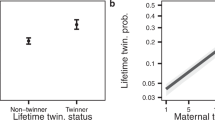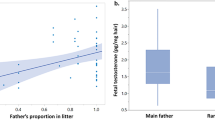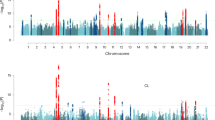Abstract
Dizygotic twinning, the simultaneous birth of siblings when multiple ova are released, is an evolutionary paradox. Twin-bearing mothers often have elevated fitness, but despite twinning being heritable, twin births occur only at low frequencies in human populations. We resolve this paradox by showing that twinning and non-twinning are not competing strategies; instead, dizygotic twinning is the outcome of an adaptive conditional ovulatory strategy of switching from single to double ovulation with increasing age. This conditional strategy, when coupled with the well-known decline in fertility as women age, maximizes reproductive success and explains the increase and subsequent decrease in the twinning rate with maternal age that is observed across human populations. We show that the most successful ovulatory strategy would be to always double ovulate as an insurance against early fetal loss, but to never bear twins. This finding supports the hypothesis that twinning is a by-product of selection for double ovulation rather than selection for twinning.
This is a preview of subscription content, access via your institution
Access options
Access Nature and 54 other Nature Portfolio journals
Get Nature+, our best-value online-access subscription
$29.99 / 30 days
cancel any time
Subscribe to this journal
Receive 12 digital issues and online access to articles
$119.00 per year
only $9.92 per issue
Buy this article
- Purchase on Springer Link
- Instant access to full article PDF
Prices may be subject to local taxes which are calculated during checkout



Similar content being viewed by others
Data availability
The data have been uploaded to Dyad and are available at https://doi.org/10.5061/dryad.h70rxwdfw.
Code availability
The computer code has been uploaded to Dyad and is available at https://doi.org/10.5061/dryad.h70rxwdfw. This code is supplied by the authors with the request that future users of the code are aware that it represents an ongoing research programme and that they contact the authors in a collaborative spirit.
References
Maynard Smith, J. Evolution and the Theory of Games (Cambridge Univ. Press, 1982).
Mbarek, H. et al. Identification of common genetic variants influencing spontaneous dizygotic twinning and female fertility. Am. J. Hum. Genet. 98, 898–908 (2016).
Bulmer, M. G. The Biology of Twinning in Man (Clarendon, 1970).
Lummaa, V., Haukioja, E., Lemmetyinen, R. & Pikkola, M. Natural selection on human twinning. Nature 394, 533–534 (1998).
Sear, R., Shanley, D., McGregor, I. A. & Mace, R. The fitness of twin mothers: evidence from rural Gambia. J. Evol. Biol. 14, 433–443 (2001).
Forbes, S. A Natural History of Families (Princeton Univ. Press, 2005).
Robson, S. L. & Smith, K. R. Twinning in humans: maternal heterogeneity in reproduction and survival. Proc. R. Soc. B 278, 3755–3761 (2011).
Rickard, I. J., Courtiol, A. & Lummaa, V. Why is lifetime fertility higher in twinning women? Proc. R. Soc. B 279, 2510–2511 (2012).
Anderson, D. J. On the evolution of human brood size. Evolution 44, 438–440 (1990).
O’Connor, K. A., Holman, D. J. & Wood, J. W. Declining fecundity and ovarian ageing in natural fertility populations. Maturitas 30, 127–136 (1998).
Centers for Disease Control and Prevention, American Society for Reproductive Medicine & Society for Assisted Reproductive Technology 2011 Assisted Reproductive Technology National Summary Report (US Dept of Health and Human Services, 2013).
McCoy, R. C. et al. Common variants spanning PLK4 are associated with mitotic-origin aneuploidy in human embryos. Science 348, 235–238 (2015).
Atkinson, D. E. Frequency of dizygotic twinning. Nature 322, 780–780 (1985).
Buzatto, B. A., Buoro, M., Hazel, W. N. & Tomkins, J. L. Investigating the genetic architecture of conditional strategies using the environmental threshold model. Proc. R. Soc. B 282, 20152075 (2015).
Shipley, P. W., Wray, J. A., Hechter, H. H., Arellano, M. G. & Borhani, N. O. Frequency of twinning in California: its relationship to maternal age, parity and race. Am. J. Epidemiol. 85, 147–156 (1967).
Nylander, P. P. S. Ethnic differences in twinning rates in Nigeria. J. Biosoc. Sci. 3, 151–158 (1971).
Enders, T. & Stern, C. The frequency of twins, relative to age of mothers in American populations. Genetics 33, 263–272 (1948).
Pollard, G. N. Multiple births in Australia, 1944–63. J. Biosoc. Sci. 1, 389–404 (1969).
Imaizumi, Y. & Hayakawa, K. Infant mortality among singletons and twins in Japan during 1999–2008 on the basis of risk factors. Twin Res. Hum. Genet. 16, 639–644 (2013).
Nybo Andersen, A. M., Wohlfahrt, J., Christens, P., Olsen, J. & Melbye, M. Maternal age and fetal loss: population based register linkage study. Brit. Med. J. 320, 1708–1712 (2000).
Donnet, M. L., Howie, P. W., Marnie, M., Cooper, W. & Lewis, M. Return of ovarian function following spontaneous abortion. Clin. Endocrinol. 33, 13–20 (1990).
Hazel, W., Smock, R. & Johnson, M. A polygenic model for the evolution and maintenance of conditional strategies. Proc. R. Soc. Lond. B 242, 181–187 (1990).
Hall, J. G. Twinning. Lancet 362, 735–743 (2003).
Fellman, J. & Eriksson, A. W. Stillbirths in multiple births: test of independence. Twin Res. Hum. Genet. 9, 677–684 (2006).
Johnson, C. D. & Zhang, J. Survival of other fetuses after a fetal death in twin or triplet pregnancies. Obstet. Gynecol. 99, 698–703 (2002).
Evron, E., Sheiner, E., Friger, M., Sergienko, R. & Harlev, A. Vanishing twin syndrome: is it associated with adverse perinatal outcome? Fertil. Steril. 103, 1209–1214 (2015).
Scaramuzzi, R. J. et al. Regulation of folliculogenesis and the determination of ovulation rate in ruminants. Reprod. Fertil. Dev. 23, 444–467 (2011).
Hoekstra, C. et al. Dizygotic twinning. Hum. Reprod. Update 14, 37–47 (2008).
Mayr, E. Cause and effect in biology. Science 134, 1501–1506 (1961).
Jean-Paul, S. & Tomas, F. First birth trends in developed countries: persisting parenthood postponement. Demogr. Res. 15, 147–180 (2006).
Pison, G., Monden, C. & Smits, J. Twinning rates in developed countries: trends and explanations. Popul. Dev. Rev. 41, 629–649 (2015).
Tomkins, J. L. & Hazel, W. The status of the conditional evolutionarily stable strategy. Trends Ecol. Evol. 22, 522–528 (2007).
R: A language and environment for statistical computing (R Foundation for Statistical Computing, 2018).
Acknowledgements
C. Lively, D. Dudle, L. Simmons, C. Smock and D. Hruschka provided comments on the manuscript drafts. We thank N. LeBas for detailed discussions of these ideas. J.L.T. was supported by a Future Fellowship (grant no. FT110100500) from the Australian Research Council. R.C.S. and W.N.H. were funded by DePauw University Faculty Development Grants.
Author information
Authors and Affiliations
Contributions
J.L.T. proposed the study. W.N.H. and J.L.T. began developing the approaches. R.S. provided the demographic data and background on the biology of twinning. R.C.S. and W.N.H. finalized the mathematical model. J.L.T. and R.B. finalized the simulation model. W.N.H. wrote the first draft of the manuscript, and all authors contributed to the completed manuscript.
Corresponding authors
Ethics declarations
Competing interests
The authors declare no competing interests.
Additional information
Peer review information Peer reviewer reports are available.
Publisher’s note Springer Nature remains neutral with regard to jurisdictional claims in published maps and institutional affiliations.
Extended data
Extended Data Fig. 1 Double ovulation as a threshold trait.
a, Three conditional (age-dependent) ovulatory strategies that differ in age of switching from single (dashed line) to double ovulation (solid line). b, Threshold trait depiction of a cohort of population with normally distributed variation in age at switching (mean age at switching from single to double ovulation is 30 yrs., SD of 3 yrs.). At age 27, the threshold (vertical line positioned at age 27) divides the population into individuals that double ovulate (those with switching ages less than 27) and single ovulate (those with switching ages greater than 27). c, As age increases, the fraction of double ovulators increases as a cumulative normal function as the threshold in b shifts to the right, increasing the fraction of the distribution of switching ages that is less than the threshold.
Extended Data Fig. 2 Age-dependent probabilities of live birth, and prenatal death from early losses, spontaneous abortion, and late losses.
a-c, points from Supplementary Table 3; lines are best fitting curves from least squared regression. a, Early loss of pregnancy (variable r in Supplementary Table 1); b. Spontaneous abortion (variable s in Supplementary Table 1); c, Late loss of pregnancy (variable t in Supplementary Table 1); d, Live birth (line from average of results in Fig. 1f; variable u in Supplementary Table 1).
Extended Data Fig. 3 Age-dependent probability of twin live births in double ovulators.
Probability of twin live births was calculated using equation 1, assuming declining probability of live birth with increasing maternal age as depicted in Extended Data Fig. 2d.
Supplementary information
Supplementary Information
Supplementary Figs. 1–3, Tables 1–3, methods and discussion.
Rights and permissions
About this article
Cite this article
Hazel, W.N., Black, R., Smock, R.C. et al. An age-dependent ovulatory strategy explains the evolution of dizygotic twinning in humans. Nat Ecol Evol 4, 987–992 (2020). https://doi.org/10.1038/s41559-020-1173-y
Received:
Accepted:
Published:
Issue Date:
DOI: https://doi.org/10.1038/s41559-020-1173-y
This article is cited by
-
Mothers with higher twinning propensity had lower fertility in pre-industrial Europe
Nature Communications (2022)



